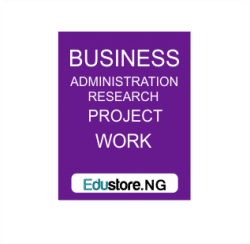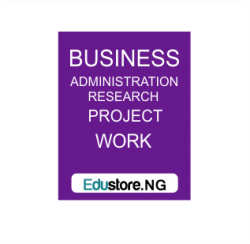CHAPTER ONE
1.0 INTRODUCTION
1.1 Background of the study
1.2 Statement of problem
1.3 Objective of the study
1.4 Research Hypotheses
1.5 Significance of the study
1.6 Scope and limitation of the study
1.7 Definition of terms
1.8 Organization of the study
CHAPTER TWO
2.0 LITERATURE REVIEW
CHAPTER THREE
3.0 Research methodology
3.1 sources of data collection
3.3 Population of the study
3.4 Sampling and sampling distribution
3.5 Validation of research instrument
3.6 Method of data analysis
CHAPTER FOUR
DATA PRESENTATION AND ANALYSIS AND INTERPRETATION
4.1 Introductions
4.2 Data analysis
CHAPTER FIVE
5.1 Introduction
5.2 Summary
5.3 Conclusion
5.4 Recommendation
Appendix
Abstract
This study is on the impact of effective leadership style on organizational performance. A case study of Dangote cement. The total population for the study is 200 staff of Dangote cement, Lokoja. The researcher used questionnaires as the instrument for the data collection. Descriptive Survey research design was adopted for this study. A total of 133 respondents made up human resource managers, production managers, senior staff and marketers were used for the study. The data collected were presented in tables and analyzed using simple percentages and frequencies
Chapter one
Introduction
- Background of the study
Organizational leadership style is a process, which allows management to be proactive rather than reactive in shaping its own future. A focused organizational leader provides and establishes visionary leadership to his organization. He understands and appreciates responsive options to the change in the management environment. He develops viable styles based upon sustainable competitive advantages. A good organizational leader develops a proactive approach to strategic management, whereby management rather than just identifying and responding to change, anticipates is the bane of indigenous business organization in developing countries. It is therefore, expected that the findings of this study will go a long way in improving the leadership class. Leadership is the ability to persuade other to seek defined objective enthusiastically. It is human fact, which binds a group together and motivates it toward it goals (David, 2003). Robin (2000) defined leadership as the ability of superiors to direct, guide and motivates people towards the attainment of given set of goals in an organization. The source of influence may be formal such as that provided by the possession of managing rank in an organization or informally outside the organization structure. Most organizational theorists agree that effective leadership is one of the most important contributors to overall organizational success
Organization look for managers who can manage effectively and efficiently. But each manager is unique with his or her style depending on the situation and inclined paradigm. Managerial style is the pattern of thinking, feeling and behaviour that a manager uses to deal with people and situation. A manager has several managerial styles such as autocratic, bureaucratic, charismatic, democratic and laissez faire (nwachwukwu, 1998). According to Basse (1982), there are managers with only one managerial style. However, most managers have a combination of those five managerial styles, although they can only be classified in various ways. Managerial style have a great impact on the organization’s operation. Effective managerial style can increase productivity, bring about empowerment, boost up employees morale, motivation and contributes positively to organization and so on. Leadership happen to be the core and of course the Nervous system in organizational solvency. (Hogan & Curphy, 1994; House Aditya, 1997; Judge & piccolo, 2004). Leadership leads to more productivity and profitability, but the extent of success depends on the style of the leader and the systematic environment created for staff functionality. Based on this background the researcher will use Dangote cement as a case study
- STATEMENT OF THE PROBLEM
A large number of organizations spend considerable huge amount on solving managerial problems. Besides, research on management’s leadership style and organizational performance are limited and personnel do not know enough about management’s leadership style and the organizational productivity. Several organizations today have the problem of leadership and the style to be adopted in leading employees. Over the years, organizations have faced the bureaucratic leadership. Consequently, many leadership ideas within the last century have affected the general effectiveness of organization’s productivity (Heurieglet, 2004). Leadership has characteristics that distinguishes it as a dynamic symbolic movement where every employee looks up to for adjustment when necessary. These characteristics explain the vital sensitive and proper positioning of leaders in organization. The absence of effective leadership is a serious problem endemic in many organizations. It is obvious that the resultant outcome is poor staff performance, absence of motivation, poor growth and development of the institutions. Hence, this would sort to investigate management leadership style and organizational performance.
1.3 OBJECTIVE OF THE STUDY
The objectives of the study are:
- To identify the various types of leadership styles adopted by managers in Dangote cement
- To determine the predominant leadership strategic adopted by manager in Dangote cement
- To determine the efficiency of such styles in achieving organizational objective in these organization
- RESEARCH HYPOTHESES
The following hypothesis will be tested
Hypothesis One:
H0: there are no various types of leadership styles adopted by managers in Dangote cement
H1: there are various types of leadership styles adopted by managers in Dangote cement
Hypothesis Two
H1: there is no efficiency of such styles in achieving organizational objective in these organization.
H0: there is efficiency of such styles in achieving organizational objective in these organization
- SIGNIFICANCE OF THE STUDY
The study of organizational leadership styles on organization changes see to be important both from the theoretical and practical perspective. The cause of organizational collapse might have wrong leadership styles, poor implementation of styles, wrong leadership styles and other elements. This study will assist to enhance the understanding of organizational leadership styles on environment as influence factor in organization changes. The result could be used as a guide for existing organization to adopt in order to survive and sustain growth. Therefore, this study can help managers to correctly adopt leadership styles for decision making which can be used to achieve, control and coordinate their activities more effectively in any organization.
- SCOPE AND LIMITATION OF THE STUDY
The scope of the study covers the impact of effective leadership style on organizational performance. case study Dangote cement. The researcher encounters some constrain which limited the scope of the study;
- a) AVAILABILITY OF RESEARCH MATERIAL: The research material available to the researcher is insufficient, thereby limiting the study
- b) TIME: The time frame allocated to the study does not enhance wider coverage as the researcher has to combine other academic activities and examinations with the study.
DEFINITION OF TERMS
LEADERSHIP: Leadership is both a research area and a practical skill encompassing the ability of an individual or organization to “lead” or guide other individuals, teams, or entire organizations
ORGANIZATIONAL PERFORMANCE: Organizational performance comprises the actual output or results of an organization as measured against its intended outputs. According to Richard et al. organizational performance encompasses three specific areas of firm outcomes: financial performance; product market performance; and shareholder return.
ORGANIZATION OF THE STUDY
This research work is organized in five chapters, for easy understanding, as follows
Chapter one is concern with the introduction, which consist of the (overview, of the study), historical background, statement of problem, objectives of the study, research hypotheses, significance of the study, scope and limitation of the study, definition of terms and historical background of the study. Chapter two highlights the theoretical framework on which the study is based, thus the review of related literature. Chapter three deals on the research design and methodology adopted in the study. Chapter four concentrate on the data collection and analysis and presentation of finding. Chapter five gives summary, conclusion, and recommendations made of the study
DOWNLOAD COMPLETE WORK- For Reference Only: Materials are for research, citation, and idea generation purposes and not for submission as your original final year project work.
- Avoid Plagiarism: Do not copy or submit this content as your own project. Doing so may result in academic consequences.
- Use as a Framework: This complete project research material should guide the development of your own final year project work.
- Academic Access: This platform is designed to reduce the stress of visiting school libraries by providing easy access to research materials.
- Institutional Support: Tertiary institutions encourage the review of previous academic works such as journals and theses.
- Open Education: The site is maintained through paid subscriptions to continue offering open access educational resources.






